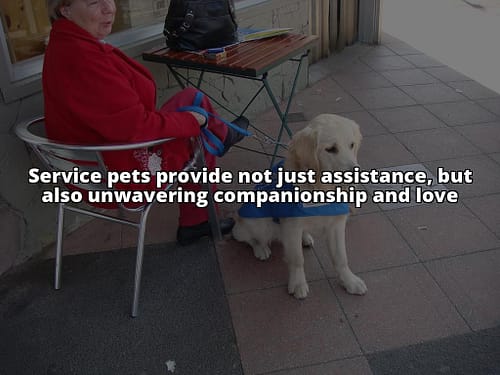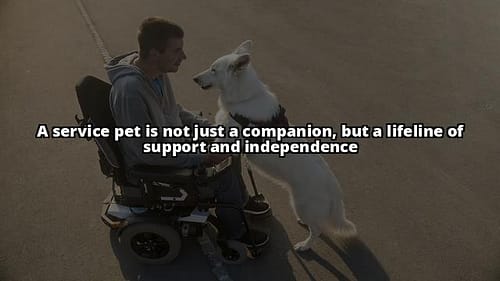Your Essential Guide to Service Pets: Rights and Responsibilities
What You’ll Learn About Service Pets
- Definition and significance of service pets.
- Legal rights and regulations for service pets.
- Responsibilities of service pet owners.

What are Service Pets and Why are They Essential?
Service pets, also known as assistance animals, are specially trained to assist individuals with disabilities in various tasks, thereby enhancing their independence and quality of life. These animals are not merely pets; they are indispensable partners for their owners, offering physical, emotional, and practical assistance. The presence of a service pet can significantly improve the daily living experiences of individuals with disabilities. From providing guidance and alerting to sounds, to aiding in mobility and performing specific tasks, service pets are instrumental in empowering their handlers to navigate the world with increased confidence and autonomy.
Understanding Service Pets

Types of Service Animals and Their Specific Roles
Service animals encompass a diverse range of species and are trained to perform specific tasks tailored to the needs of their handlers. Guide dogs assist individuals with visual impairments by navigating obstacles and providing directional commands. Hearing dogs alert their handlers to important sounds, such as doorbells or alarms. Additionally, mobility assistance animals aid individuals with physical disabilities by retrieving items, opening doors, and providing stability and balance support.
The Bond between Service Pets and Their Handlers
The relationship between a service pet and its handler is built on trust, mutual respect, and a deep understanding of each other’s needs and cues. This bond goes beyond companionship; it is a partnership based on clear communication and reliance, where the pet becomes an extension of the handler.
How Service Pets Differ from Therapy Animals and Emotional Support Animals
It’s essential to differentiate service pets from therapy animals and emotional support animals. While therapy animals provide comfort and support in institutional settings, such as hospitals and nursing homes, and emotional support animals offer companionship and alleviate symptoms of mental health conditions, service pets are trained to perform specific tasks directly related to their handler’s disability.

Legal Rights and Regulations for Service Pets
Americans with Disabilities Act (ADA) and Its Provisions for Service Animals
The ADA recognizes the importance of service animals in enabling individuals with disabilities to fully participate in society. It mandates that state and local government agencies, businesses, and nonprofit organizations that serve the public must allow service animals to accompany people with disabilities in all areas where the public is normally allowed to go.
Public Access Rights for Individuals with Disabilities and Their Service Pets
Individuals with disabilities and their service pets have the legal right to enter and use public facilities, including restaurants, hotels, and public transportation, without being segregated or subjected to additional charges. These rights are vital in ensuring equal access and opportunities for people with disabilities.
Legal Protections against Discrimination for Service Pet Owners
Service pet owners are protected by law from discrimination based on their disability or the presence of their service animal. It is illegal for businesses or housing providers to refuse entry or accommodation to individuals with disabilities who rely on service pets.
Training and Certification of Service Animals
The Comprehensive Training Process for Service Pets
Service animals undergo rigorous training to acquire the skills necessary to assist their handlers effectively. The training process includes obedience training, task-specific training, and socialization to ensure the animals can perform reliably in various environments.
Specific Skills and Tasks Trained for Different Types of Service Animals
Guide dogs are trained to navigate around obstacles, stop at curbs, and maneuver through crowded spaces. Hearing dogs are taught to respond to specific sounds and alert their handlers. Mobility assistance animals are trained to retrieve items, open doors, and provide balance support.
Certification and Registration of Service Animals
While there is no formal certification or registration process for service animals under the ADA, some organizations offer voluntary certification and identification for service animals to help streamline access and alleviate potential conflicts in public settings.

Responsibilities of Service Pet Owners
Proper Care, Health, and Well-being of Service Animals
Service pet owners must prioritize the physical and emotional well-being of their animals, ensuring they receive regular veterinary care, nutritious diets, exercise, and mental stimulation. Maintaining their health is essential for their ability to perform their duties effectively.
Maintaining Training and Behavior Standards in Public Settings
Owners of service pets are responsible for ensuring their animals exhibit appropriate behavior in public places, including remaining calm and focused on their tasks, and not engaging in disruptive or aggressive behavior.
Financial and Emotional Commitment of Owning a Service Pet
Owning a service pet entails a significant emotional and financial commitment. From the initial cost of acquiring a trained service animal to ongoing expenses for their care and well-being, it is essential for owners to be prepared for the long-term responsibilities associated with their service pet.
Public Access and Etiquette
Guidelines for the General Public on Interacting with Service Pets
Members of the public should respect the working status of service animals and refrain from attempting to pet, feed, or distract them while they are performing their duties. It’s vital to remember that these animals are working and should not be disturbed.
Importance of Not Distracting Service Animals while They Are Working
Distracting a service pet can compromise the safety and well-being of their handler. It’s crucial for bystanders to refrain from interacting with or interrupting service animals to ensure they can focus on their tasks without interference.
Addressing Common Misconceptions and Myths about Service Pets
Education plays a pivotal role in dispelling misconceptions about service animals. Common myths, such as the belief that all service animals are large breeds or that they must wear special vests, need to be corrected to foster a more inclusive and understanding environment for service pet owners.

Personal Stories and Testimonials
Real-life Experiences of Individuals who Rely on Service Pets
Personal anecdotes from individuals who rely on service pets offer valuable insights into the daily challenges they face and the indispensable support provided by their animals. These stories provide a firsthand perspective on the profound impact of service pets on the lives of their handlers.
Impact of Service Pets on Daily Life, Independence, and Mental Well-being
Service pets play a pivotal role in enhancing the independence, confidence, and mental well-being of their handlers. They provide a sense of security and empowerment, enabling individuals with disabilities to navigate the world with increased freedom and reassurance.
Success Stories and Challenges Faced by Service Pet Owners
Sharing success stories and challenges faced by service pet owners sheds light on the triumphs and obstacles encountered in their journey. It underscores the resilience and determination of individuals who rely on service pets and the transformative impact of these animals on their lives.
New Section: The Life-Changing Impact of Service Pets
Sarah’s Story: Overcoming Challenges with a Guide Dog
Sarah, a visually impaired individual, found herself navigating the bustling streets of New York City with the help of her guide dog, Luna. Before Luna came into her life, Sarah faced many obstacles and fears when it came to traveling independently. However, with Luna by her side, Sarah gained a newfound sense of freedom and confidence.
Luna not only guided Sarah through busy intersections and crowded spaces but also provided emotional support during anxiety-inducing situations. With Luna’s assistance, Sarah was able to pursue her dream of attending college and excelling in her studies, knowing that Luna was there to help her every step of the way.
Sarah’s story exemplifies the life-changing impact of service pets, not only in terms of practical assistance but also in their ability to empower individuals with disabilities to lead fulfilling and independent lives. Through her experiences with Luna, Sarah has become a passionate advocate for the rights of service pet owners and a living testament to the transformative bond between a handler and their service animal.
Resources and Support for Service Pet Owners
Organizations and Support Groups for Service Pet Owners
Numerous organizations and support groups offer guidance, advocacy, and community for service pet owners. These resources provide a network of support and information for navigating the responsibilities and challenges associated with owning a service pet.
Assistance with Training, Advocacy, and Legal Rights
Service pet owners can access assistance and guidance on training, advocacy, and understanding their legal rights through specialized organizations and professionals dedicated to supporting the needs of individuals with service animals.
Financial Aid and Resources for Acquiring and Maintaining a Service Pet
Financial aid and resources are available to help individuals with disabilities acquire and maintain service pets. From assistance with initial acquisition costs to veterinary care and ongoing support, these resources aim to alleviate the financial burden associated with owning a service animal.
Future Developments in Service Pet Support
Ongoing Research and Advancements in Service Pet Training
Continuous research and advancements in service pet training aim to enhance the effectiveness and scope of assistance provided by service animals. From innovative training techniques to expanding the range of tasks performed, ongoing developments seek to optimize the support offered by service pets.
Potential Areas for Improvement in Legislation and Public Awareness
Efforts to enhance legislation and increase public awareness about the rights and needs of individuals with service animals are ongoing. Advocacy for improved access, reduced discrimination, and heightened understanding of service pet owners’ rights remains a crucial area for future development.
The Evolving Role of Service Pets in Society
The role of service pets in society continues to evolve, with increasing recognition of their importance in promoting independence, accessibility, and inclusivity for individuals with disabilities. As their impact becomes more widely acknowledged, service pets are poised to play an even more significant role in empowering and supporting their handlers.
Conclusion
Service pets are indispensable allies for individuals with disabilities, offering crucial support, companionship, and assistance in navigating daily life. Their impact extends beyond practical assistance, profoundly influencing the independence and well-being of their handlers. Encouraging greater understanding, empathy, and support for service pet owners is essential in fostering a more inclusive and accommodating environment. Recognizing the rights and responsibilities associated with service pets contributes to creating a more accessible and compassionate society.
For further information and support, you can explore the following resources:
- Service Animal Legal Definition – Provides detailed information about the legal definition of service animals under the Americans with Disabilities Act (ADA).
- International Association of Assistance Dog Partners – Offers resources and support for individuals with service animals, including training, advocacy, and community.
- Assistance Dogs International – A coalition of not-for-profit organizations that train and place assistance dogs, offering valuable resources and guidance for service pet owners.
By exploring these resources, you can gain a deeper understanding of service pets and access the support necessary to navigate the responsibilities and challenges associated with owning a service pet.




Leave a Reply